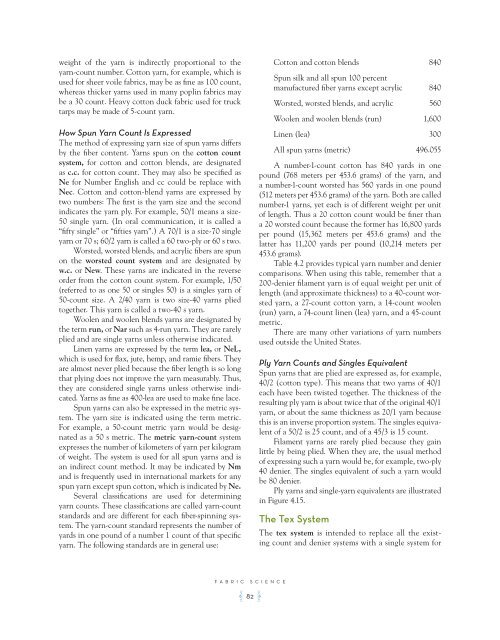Create successful ePaper yourself
Turn your PDF publications into a flip-book with our unique Google optimized e-Paper software.
weight of the yarn is indirectly proportional to the<br />
yarn-count number. Cotton yarn, for example, which is<br />
used for sheer voile fabrics, may be as fine as 100 count,<br />
whereas thicker yarns used in many poplin fabrics may<br />
be a 30 count. Heavy cotton duck fabric used for truck<br />
tarps may be made of 5-count yarn.<br />
How Spun Yarn Count Is Expressed<br />
The method of expressing yarn size of spun yarns differs<br />
by the fiber content. Yarns spun on the cotton count<br />
system, for cotton and cotton blends, are designated<br />
as c.c. for cotton count. They may also be specified as<br />
Ne for Number English and cc could be replace with<br />
Nec. Cotton and cotton-blend yarns are expressed by<br />
two numbers: The first is the yarn size and the second<br />
indicates the yarn ply. For example, 50/1 means a size-<br />
50 single yarn. (In oral communication, it is called a<br />
“fifty single” or “fifties yarn”.) A 70/1 is a size-70 single<br />
yarn or 70 s; 60/2 yarn is called a 60 two-ply or 60 s two.<br />
Worsted, worsted blends, and acrylic fibers are spun<br />
on the worsted count system and are designated by<br />
w.c. or New. These yarns are indicated in the reverse<br />
order from the cotton count system. For example, 1/50<br />
(referred to as one 50 or singles 50) is a singles yarn of<br />
50-count size. A 2/40 yarn is two size-40 yarns plied<br />
together. This yarn is called a two-40 s yarn.<br />
Woolen and woolen blends yarns are designated by<br />
the term run, or Nar such as 4-run yarn. They are rarely<br />
plied and are single yarns unless otherwise indicated.<br />
Linen yarns are expressed by the term lea, or NeL,<br />
which is used for flax, jute, hemp, and ramie fibers. They<br />
are almost never plied because the fiber length is so long<br />
that plying does not improve the yarn measurably. Thus,<br />
they are considered single yarns unless otherwise indicated.<br />
Yarns as fine as 400-lea are used to make fine lace.<br />
Spun yarns can also be expressed in the metric system.<br />
The yarn size is indicated using the term metric.<br />
For example, a 50-count metric yarn would be designated<br />
as a 50 s metric. The metric yarn-count system<br />
expresses the number of kilometers of yarn per kilogram<br />
of weight. The system is used for all spun yarns and is<br />
an indirect count method. It may be indicated by Nm<br />
and is frequently used in international markets for any<br />
spun yarn except spun cotton, which is indicated by Ne.<br />
Several classifications are used for determining<br />
yarn counts. These classifications are called yarn-count<br />
standards and are different for each fiber-spinning system.<br />
The yarn-count standard represents the number of<br />
yards in one pound of a number 1 count of that specific<br />
yarn. The following standards are in general use:<br />
FABRIC SCIENCE<br />
A 82 F<br />
Cotton and cotton blends 840<br />
Spun silk and all spun 100 percent<br />
manufactured fiber yarns except acrylic 840<br />
Worsted, worsted blends, and acrylic 560<br />
Woolen and woolen blends (run) 1,600<br />
Linen (lea) 300<br />
All spun yarns (metric) 496.055<br />
A number-1-count cotton has 840 yards in one<br />
pound (768 meters per 453.6 grams) of the yarn, and<br />
a number-1-count worsted has 560 yards in one pound<br />
(512 meters per 453.6 grams) of the yarn. Both are called<br />
number-1 yarns, yet each is of different weight per unit<br />
of length. Thus a 20 cotton count would be finer than<br />
a 20 worsted count because the former has 16,800 yards<br />
per pound (15,362 meters per 453.6 grams) and the<br />
latter has 11,200 yards per pound (10,214 meters per<br />
453.6 grams).<br />
Table 4.2 provides typical yarn number and denier<br />
comparisons. When using this table, remember that a<br />
200-denier filament yarn is of equal weight per unit of<br />
length (and approximate thickness) to a 40-count worsted<br />
yarn, a 27-count cotton yarn, a 14-count woolen<br />
(run) yarn, a 74-count linen (lea) yarn, and a 45-count<br />
metric.<br />
There are many other variations of yarn numbers<br />
used outside the United States.<br />
Ply Yarn Counts and Singles Equivalent<br />
Spun yarns that are plied are expressed as, for example,<br />
40/2 (cotton type). This means that two yarns of 40/1<br />
each have been twisted together. The thickness of the<br />
resulting ply yarn is about twice that of the original 40/1<br />
yarn, or about the same thickness as 20/1 yarn because<br />
this is an inverse proportion system. The singles equivalent<br />
of a 50/2 is 25 count, and of a 45/3 is 15 count.<br />
Filament yarns are rarely plied because they gain<br />
little by being plied. When they are, the usual method<br />
of expressing such a yarn would be, for example, two-ply<br />
40 denier. The singles equivalent of such a yarn would<br />
be 80 denier.<br />
Ply yarns and single-yarn equivalents are illustrated<br />
in Figure 4.15.<br />
The Tex System<br />
The tex system is intended to replace all the existing<br />
count and denier systems with a single system for













